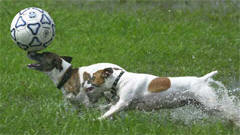|
|
Nutrition and the Performance Dog Contributed by The Crew at SportMutt Sunday, 6 November 2005 What Is A Performance Dog? |
|
||
|
Other examples are less obvious, but more common. Show dogs must perform and require high levels of energy to be successful. Dogs that accompany their owners on long daily runs or on frequent backpacking trips are another example. Another example, and of course one that we are very focused on in DockDogs is the Dock Jumping dog. Big Air and Extreme Vertical competitions along with weekly training in endurance, strength and conditioning all require high performance. The key is energy. If a dog is asked to regularly perform tasks that require extra energy (calories), it can be classified as a performance dog. Performance Dogs Have Special Nutritional Needs Like
all dogs, performance dogs need complete and balanced food. In addition,
they need a ready supply of water because dehydration can occur rapidly
during strenuous work. Recognizing A Good Dog Food For Performance Dogs Calories come from three sources: protein, carbohydrates, and fat. Protein, preferably a high-quality animal-based protein, does more than provide energy. It is important to a performance dog’s diet because it provides essential amino acids for muscle building, tissue repair, hormone synthesis, and other metabolic processes associated with high activity. Carbohydrates like corn meal, barley, and grain sorghum are an excellent source of quick energy for performance dogs. In order for performance dogs to receive enough energy from either proteins or carbohydrates, they would need to consume a large volume of food. Fat contains more than twice the amount of energy as protein or carbohydrates, which means more energy can be contained in a smaller amount of a high-fat food. High-quality fat from chicken and fish also provides omega-6 and omega-3 fatty acids. Research has shown that an omega-6:omega-3 fatty acid ratio of 5:1 to 10:1 helps keep a dog’s skin and coat healthy even during the most strenuous activities. Some fiber sources, like the moderately fermentable fiber beet pulp, are important for providing energy to cells lining the intestine, which in turn, helps maintain gut health for good nutrient absorption and quick, clean bowel movements during activity. Feeding Performance Dogs For best results, high-performance dogs need to be fed a calorie and nutrient-dense food at least 8 weeks before the stressful time begins. This way the mitochondria, fuel-burning components inside the dogs’ muscle cells, can prepare to use the extra fat and energy in a more efficient manner. If the dog performs seasonally, switching to a less calorie dense food may help the dog avoid excess weight gain during the off season. When switching foods, introduce the new food gradually by mixing 25% new food with 75% old food. During the next 3 days, continue increasing amounts of new food while decreasing amounts of old food. If the dog maintains a high level of activity throughout the year, feeding a calorie and nutrient-dense food every day is best. Application
|
||||
|
|
||||
|
|
||||
